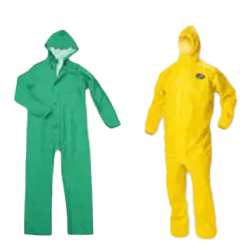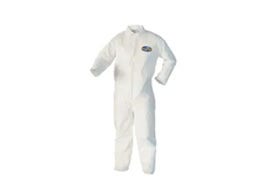
Chemical Resistant Coveralls
One-piece garments manufactured from specialty chemical-resistant materials. Primarily designed to protect the wearer from liquid chemical splash or spray with options for providing additional protection against infective agents, radioactive contamination, and static electricity.
Useful Links
Selector Guide
Save Now - Exclusive Deals
Product Code 8008002
Product Code 8003111
Product Code 8008018
Product Code 7074261
Product Code 8008013
Product Code 8008014
Product Code 17835676
Product Code 8008007
Product Code 200022862
Product Code 18000130
Product Code 200022870
Product Code 17120905
Must Have
Product Code 7146525
Product Code 7074269
Product Code 8349003
Product Code 15661784
Product Code 7237796
Product Code 15799027
Product Code 15896942
Product Code 8008019
Complete Your Order - Great Deals
Product Code 12687071
Product Code 15747727
Product Code 12841388
FAQ
- Resistance against penetration of chemicals
- Mechanical resistance against abrasion, punctures or tears
- In particular applications, antistatic properties and resistance against pathogens or radioactive material are required
- The coverall should meet relevant safety standards and certifications (e.g., OSHA, ANSI, EN standards) specific to chemical protective clothing
Chemical protection suits are further classified according to the time it takes for a certain concentration of a chemical to penetrate through the protective suit. The longer the breakthrough time the higher the resistance to permeation and the more effective the chemical protection.
Protection Class | Breakthrough Times |
|---|---|
1 | > 10 minutes |
2 | > 30 minutes |
3 | > 60 minutes |
4 | > 120 minutes |
5 | > 240 minutes |
6 | > 480 minutes |
Coveralls differ according to their ability to resist mechanical, chemical, and particulate elements.
Class I coveralls are intended for use in households and environments with low risk exposure.
Class III coveralls are designed for use in environments with high risk exposure.
The following types of Class III coverall are available:
Coverall Type | Protection Level |
|---|---|
Type 1, 1a, 1b, 1c | Gas tight |
Type 3 | Protection against fluids |
Type 4 | Protection against spray |
Type 5 | Protection against particles |
Type 6 | Limited protection against spray |
The requirements that need to be met for the various levels of chemical protection apparel are set in the following European standards:
EN 943-1: Type 1a, 1b and 1c | Protective clothing against liquid and gaseous chemicals, including liquid aerosols and solid particles – Part 1: Performance requirements for ventilated and non-ventilated ‘gas-tight’ (type 1) |
EN 943-2: Type 1a ET and type 1b ET | Protective clothing against liquid and gaseous chemicals, including liquid (for emergency teams), aerosols and solid particles – Part 2: performance requirements for gas-tight (type 1) chemical protective suits for emergency teams (ET) |
EN 14605: Type 3 and 4 | Protective clothing against liquid chemicals – performance requirements for clothing with liquid-tight (type 3) or spray-tight (type 4) connections, including items providing protection to parts of the body only (types PB [3] and PB [4]) |
EN ISO 13 982-1: Type 5 | Protective clothing for use against solid particulates – Part 1: performance requirements for chemical protective clothing providing protection to the full body against airborne solid particulates (type 5 clothing) |
EN 13 034: Type 6 | Protective clothing against liquid chemicals – performance requirements for chemical protective clothing offering limited protective performance against liquid chemicals (type 6 and type PB [6] equipment) |
Furthermore, the following standard testing methods are prescribed for chemical protection apparel:
- EN ISO 6529 Protective clothing – protection against chemicals – determination of resistance of protective clothing materials to permeation by liquids and gases
- EN 1149-5 Protective clothing – electrostatic properties
- EN ISO 16602 Protective clothing for protection against chemicals – classification, labelling and performance requirements
Consult your safety manager who needs to perform a risk assessment on the working environment. Share the specifics of your application. Based on these you will be able to determine together:
- What work needs to be performed: The type and duration of the work will largely determine the protection level and class
- What risks are associated with the work: Which chemicals are being used and which mixtures are being produced - are hazardous materials present in particulate, liquid or gaseous form? What is the temperature range of the working environment, does the application involve working with flammable or explosive substances, and is there increased risk of abrasion, tear or puncturing of the protective suit? Consider cumulative effects of the exposure to hazardous materials
- What other protective equipment is required for the application and is this compatible with the chosen protective suit: Important considerations are the use of additional breathing apparatus, eye and face protection, hearing or head protection gear, gloves, protective boots, and securing belts etc
- What options are available for decontamination of the protective gear: The above aspects will largely determine the use of disposable or reusable chemical-resistant coveralls and disposal or decontamination will need to be organized accordingly
- Seek recommendations from your local Fisher Scientific Channel Account Manager or Safety Specialist, who will be able to advise on appropriate solutions


















_CAT_1.jpg-650.jpg)





















